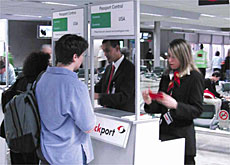Spy technology takes security a step further

College students in Biel have developed a face recognition system that could revolutionise banking security, and help police in the fight against crime.
As part of their diploma work for the School of Engineering and Information Technology (HTI), Chris Bürgi and Andry Joos came up with Face Off, a system that uses a hidden camera to film its subjects.
The images captured are fed into a computer database, which compares them with the photos in its memory.
There is nothing new about using biological data as a means of identification.
Since December 2004, passengers at Zurich Airport have been checking onto flights using the Secure Check system.
This is a smart card containing biometric data, including fingerprints and a photograph, as well as passport information.
What is new about Face Off is that it is a framework – the software can be put together in different ways, depending on the application. Although it has not yet been commercially developed, its inventors believe the software has great potential.
Surveillance
Head of the research group Roger Cattin says the system was set up to identify people, possibly trouble makers, in a crowd.
HTI uses the surveillance system to check for intruders entering the building, having experienced a number of thefts recently.
The technician takes a frame of a face captured on camera and “normalises” it by putting the eyes in a horizontal position and scaling the face, to make it easier to compare with stored images. Then a mask or grid is applied.
“At certain points like the eyes, nose, mouth top and bottom, and jaw, we extract some values with mathematical formulas, and these are used for comparison with other photos,” explains Bürgi. “We also measure the distance between these points.”
Having made the comparison, Face Off produces an accuracy value, ranging from 0 to 1, with 0 denoting an exact match with a stored image.
The students were able to use existing face recognition modules and adapt them to develop the new framework.
Accuracy
Andry Joos says they were surprised by their success. “I’m very pleased with it considering we only had eight weeks for all the work. There are certainly things that we could refine and change and also possibly add, to enhance the functionality. But generally I’m very pleased.”
To function efficiently, the system relies on the new image being captured with similar lighting conditions to the stored picture.
Bürgi says the software would probably fail to recognise the difference between twins, and could be confused by the removal or addition of facial hair.
But Face Off would recognise a subject wearing glasses, even if it had been trained not to expect them.
Moving On
The two young technicians have now left college and are working as fully-fledged software engineers, with degrees under their belts.
This does not mean that Face Off is destined to sit on the HTI shelves, gathering dust. Cattin has great ambitions for the software.
“We are going to try to put a camera in a smart card. The prime usage will be iris recognition, because faces are not distinct enough to be used for safe authentication”, he says.
Cattin and two HTI colleagues from the School of Engineering and Information have set up a spin-off to try to commercialise this and other projects.
swissinfo, Julie Hunt in Biel
HTI students try to develop cutting edge projects with commercial and database applications.
The computer perception group led by Roger Cattin works with Swiss industries to develop diploma projects.
Cattin has set up a spin off to commercialise HTI products.
College students in Biel have taken biometric authentification a step further with a new face recognition system, using a framework that can be adapted to different purposes.
swissinfo met the developers at the School of Engineering and Information Technology, and found out how it works.

In compliance with the JTI standards
More: SWI swissinfo.ch certified by the Journalism Trust Initiative



You can find an overview of ongoing debates with our journalists here . Please join us!
If you want to start a conversation about a topic raised in this article or want to report factual errors, email us at english@swissinfo.ch.